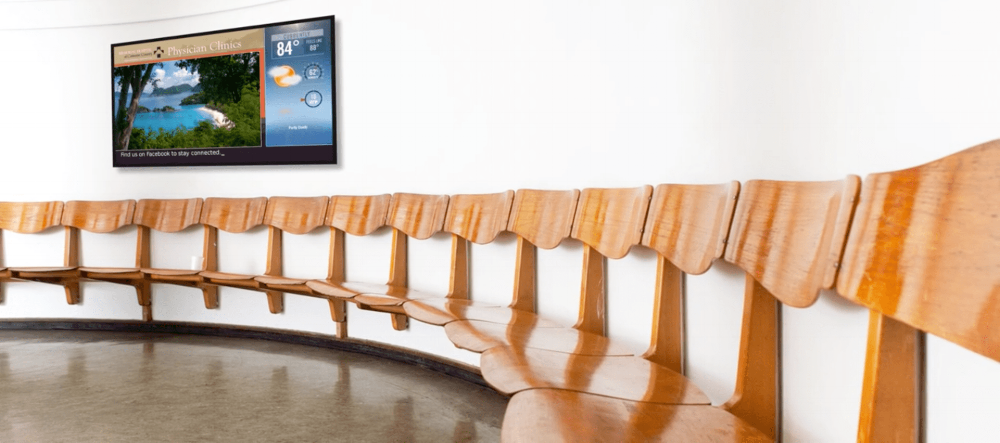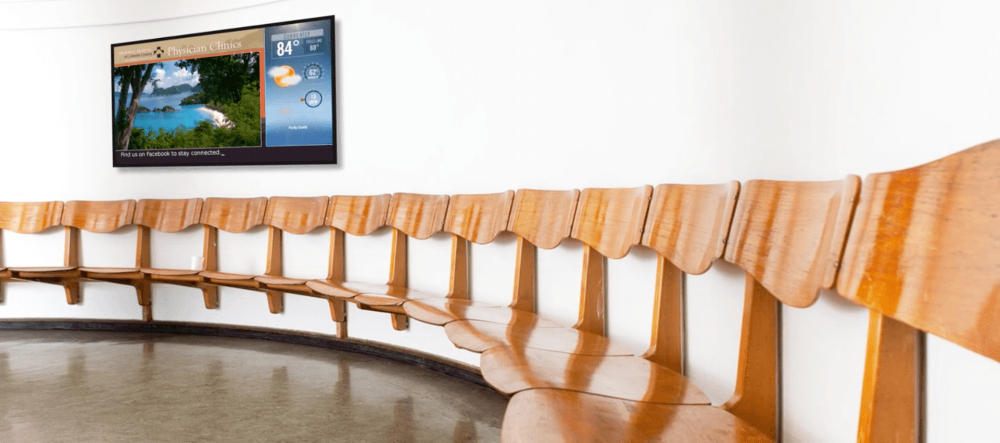
Video is one of the most powerful mediums for capturing and holding attention. It is also one of the most versatile.
Video works effectively as a communication and a marketing tool and can be distributed across multiple platforms in both digital and physical locations. Watch the video below to see examples of different types of content that can be used on digital screens in healthcare settings:
For healthcare marketing and communication, videos are often found in:
- Staff-Facing Digital Signage Content — Screens are posted near workstations, training rooms, and employee break rooms to communicate with an internal team.
- Client-Facing Digital Signage Content — Screens are posted in waiting areas, patient rooms, and lobbies to connect with patients and clients.
- Website Content — Videos are displayed on websites to increase visitor engagement and improve search rankings.
- YouTube Uploads — Videos are uploaded directly to YouTube to help audiences find information through search.
- Video Clips on Social Media — Video are shared through social media to increase audience engagement as videos are shared far more than text and graphics alone.
- Email Newsletter Content — Videos are used in email newsletters because when the word “video” is in an email subject line, it boosts open rates and click-through rates and reduces the amount of unsubscribes.
One of the great things about working with video content is that it can be created, repurposed, and shared through a variety of platforms. You can create one video and find multiple ways to use it.
Ways to Utilize Video in Healthcare Marketing and Communications
You can use video in a healthcare facility to benefit patients, visitors, and staff alike.
1. Welcome patients. Place video content near the entrance of the facility or in the waiting room to welcome visitors. You can offer an overview of the facility and direct visitors to their location.
2. Introduce doctors, nurses, and staff. During your welcome video, you can introduce key staff members and doctors. Share interviews or discuss the background of your team to help patients get to know the staff.
3. Share patient testimonials. Provide credibility for your office and ease the mind of your patients by sharing video testimonials from past patients. Before-and-afters and reviews from happy patients will make your new patients feel more comfortable working with you.
4. Provide a virtual tour. Take first-time patients through your office with a virtual tour. Patients who are unfamiliar with your office will enjoy getting a first look before walking through the doors of your location.
5. Explain procedures. It can be comforting for patients to know what to expect during their appointment or procedure. Use video to educate them and explain what will happen during their visit.
6. Answer frequently asked questions. Video is a good way to answer questions that patients frequently ask. Use video as an opportunity to give detailed answers with visuals to help educate your patients.
7. Explain home health procedures. At-home aftercare is often a vital part of a patient’s recovery. So make sure they know how to properly perform home health procedures by using video to teach and explain. Videos also serve as a great tool for continued training if a patient needs to revisit and remember their treatment plans at a later time.
8. Share general health advice. Because you care about the overall well-being of your patients, you can use video to share information, tips, and advice on how to improve their general health.
9. Create a library of resources. Don’t let an old video or clip go to waste. Curate all of your videos to create a resource portal on your website or through an interactive content board in your office.
10. Entertain waiting patients and visitors. When you share informative and entertaining video with your visitors and patients, you improve their experience while at your office. Video content in a waiting room creates a more enjoyable visit and decreases perceived wait time.
11. Boost morale. Video content can also decrease stress and boost patient morale. Uplifting content used in waiting and recovery rooms can help patients and their families release nervous energy and anxiety and take their mind off the situation.
12. Highlight awareness initiatives. Instead of using tired, static signs and brochures, spread the news about healthcare awareness months, days, and weeks using video messaging and promotions.
13. Promote products and services. Let patients and visitors know about other preventative and elective care services and products that your facilities offers through video promos.
14. Promote an upcoming event. Invite your audience to join your next event by using video to share clips from recent events and show patients and visitors what they can gain by attending.
15. Welcome new staff. Videos don’t always need to be directed to patients. Use video as an orientation tool for new staff. The video can include an introduction to your mission, team, and processes.
16. Provide employee training. Video training is an effective way to teach new staff and refresh the minds of seasoned staff. Instructional videos can be used as an introductory training then kept in a resource so staff can go back and review material when needed.
There are multiple effective ways to use and distribute video for healthcare marketing and communication initiatives.
So, why are you still using static graphics and text to share your messaging?
If you are stuck with dated communication and marketing tools and are ready to make an upgrade, learn more about bringing video content to you healthcare practice.
Schedule a free consultation with a Spectrio specialist to see how our video production services can improve your healthcare marketing and take your communication to the next level.
